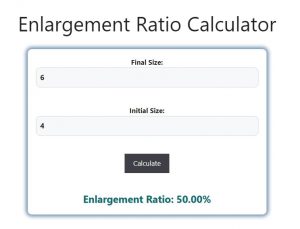About Enlargement Ratio Calculator (Formula)
The enlargement ratio is a valuable metric used in various fields, including photography, printing, and engineering, to quantify the increase in size of an object or image compared to its original dimensions. Whether you’re working on resizing images, analyzing the scale of architectural models, or determining the magnification of lenses, understanding and calculating the enlargement ratio can help you achieve precise results. The Enlargement Ratio Calculator simplifies this process, allowing users to quickly and accurately determine the ratio of enlargement.
Formula
The formula for calculating the enlargement ratio is:
Enlargement Ratio (ER) = ((Final Size – Initial Size) / Initial Size) * 100
How to Use
Using the Enlargement Ratio Calculator is straightforward:
- Determine Sizes: Measure the initial and final sizes of the object or image you are analyzing.
- Input Values: Enter the initial size and final size into the calculator.
- Calculate: Click the calculate button to determine the enlargement ratio.
- Review Results: The calculator will display the enlargement ratio as a percentage, giving you a clear understanding of the size change.
Example
Suppose you have an image that was originally 4 inches wide and has been resized to 6 inches.
- Initial Size: 4 inches
- Final Size: 6 inches
Using the formula:
ER = ((Final Size – Initial Size) / Initial Size) * 100
ER = ((6 – 4) / 4) * 100
ER = (2 / 4) * 100
ER = 0.5 * 100
ER = 50%
In this example, the enlargement ratio is 50%, indicating that the image has increased in size by half of its original size.

FAQs
- What is an enlargement ratio?
The enlargement ratio measures how much larger an object or image has become compared to its original size. - Why is the enlargement ratio important?
It helps in understanding scaling effects in photography, design, and engineering, ensuring accurate representations and measurements. - What fields use enlargement ratios?
Enlargement ratios are used in photography, printing, engineering, and any field that involves resizing objects or images. - How do I interpret the enlargement ratio?
A positive enlargement ratio indicates an increase in size, while a negative ratio suggests a decrease. - Can the enlargement ratio be less than zero?
Yes, if the final size is smaller than the initial size, the enlargement ratio will be negative. - How do I calculate the enlargement ratio manually?
Use the formula: (Final Size – Initial Size) / Initial Size * 100, and input your measurements. - Is the enlargement ratio expressed in percentage?
Yes, the result is typically expressed as a percentage for easier interpretation. - What if I have multiple dimensions to consider?
Calculate the enlargement ratio for each dimension separately, such as width and height. - Can I use the calculator for non-linear dimensions?
Yes, the calculator can be used for any measurable change in size, whether linear or not. - Is there a limit to how large I can enlarge an object?
The practical limit depends on the medium and purpose, as excessive enlargement may lead to loss of detail or distortion. - What are some common applications of the enlargement ratio?
Common applications include image resizing for printing, magnifying lenses in optics, and scaling architectural models. - Do I need to convert measurements before using the calculator?
Ensure all measurements are in the same units before inputting them into the calculator. - Can I calculate a reduction ratio using the same method?
Yes, the same formula applies, but interpret the results accordingly to reflect a decrease in size. - What tools can I use to measure the initial and final sizes?
Use rulers, calipers, or digital measuring tools to obtain accurate size measurements. - How precise do my measurements need to be?
The precision depends on the application; for detailed work, more precise measurements are necessary. - Is there an industry standard for acceptable enlargement ratios?
Standards vary by field; check with relevant industry guidelines for specific requirements. - What if I want to compare multiple enlargement ratios?
Calculate each enlargement ratio separately and compare the percentages to assess differences. - Can this calculator be used for different units of measurement?
Yes, just ensure that the same units are used for both initial and final sizes. - What are some common mistakes when calculating enlargement ratios?
Common mistakes include incorrect measurements, miscalculating the formula, or using inconsistent units. - Where can I learn more about enlargement ratios and their applications?
Consider online resources, tutorials, or textbooks related to photography, engineering, or design.
Conclusion
The Enlargement Ratio Calculator is an essential tool for anyone dealing with size changes in images, models, or objects. By accurately calculating the enlargement ratio, users can ensure precise results, whether for artistic purposes, engineering projects, or personal applications. Understanding how to use this calculator not only streamlines the resizing process but also enhances the overall quality and accuracy of work across various fields.